New Zealand Data Center Construction Market Size
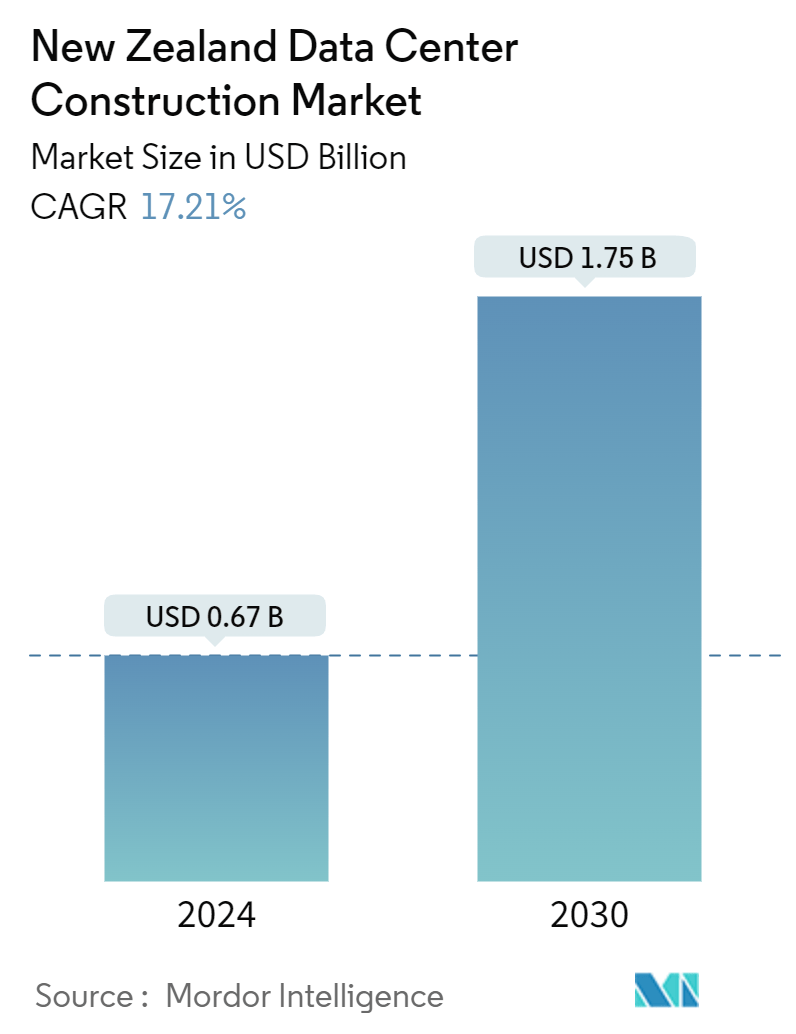
| Study Period | 2019 - 2029 |
| Base Year For Estimation | 2023 |
| Market Size (2024) | USD 0.67 Billion |
| Market Size (2030) | USD 1.75 Billion |
| CAGR (2024 - 2030) | 17.21 % |
| Market Concentration | Medium |
Major Players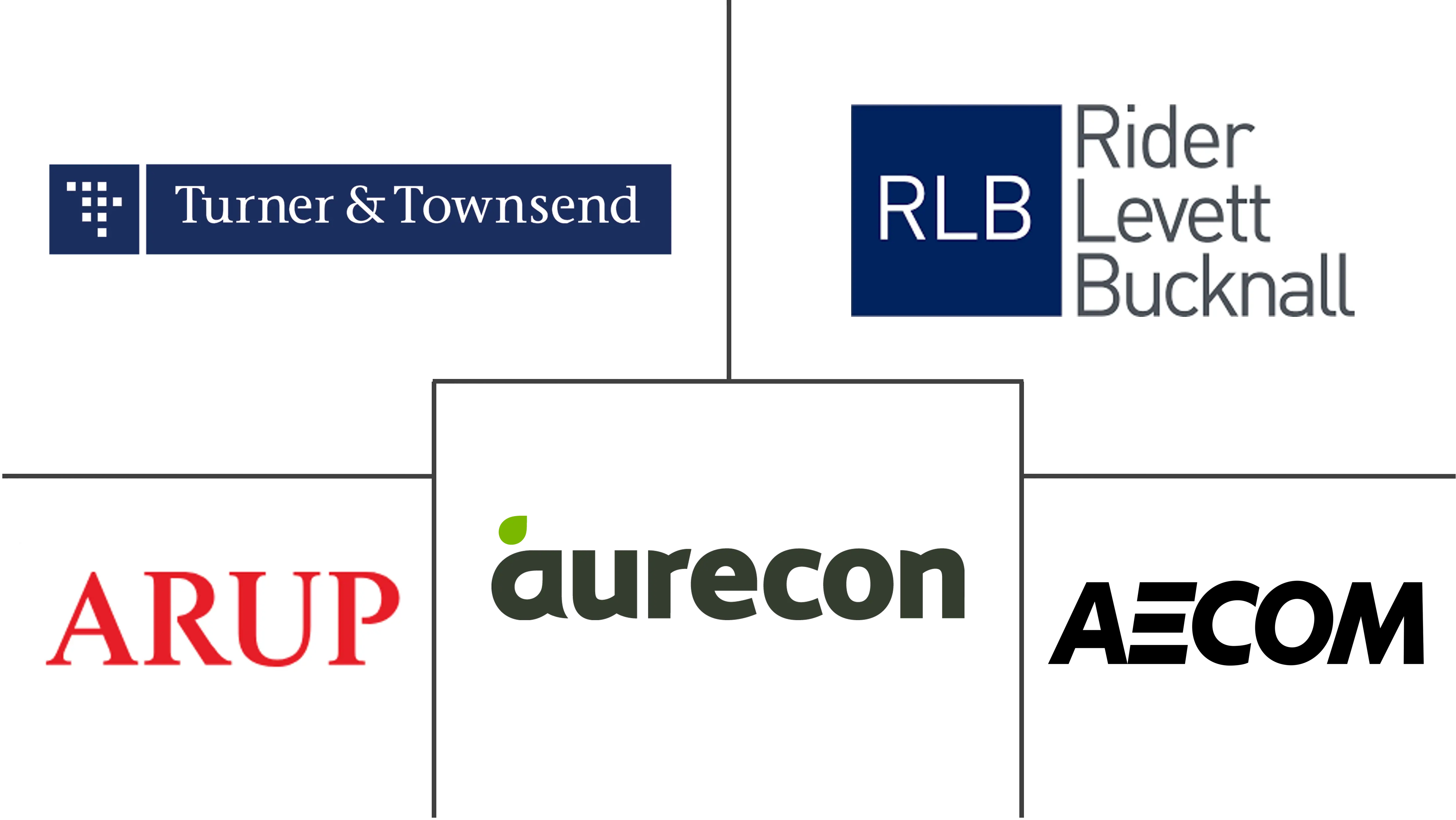
*Disclaimer: Major Players sorted in no particular order |
New Zealand Data Center Construction Market Analysis
The New Zealand Data Center Construction Market size is estimated at USD 0.67 billion in 2024, and is expected to reach USD 1.75 billion by 2030, growing at a CAGR of 17.21% during the forecast period (2024-2030).
- The upcoming IT load capacity in the region is expected to reach more than 300 MW by 2030 for under construction IT load capacity.
- The construction of raised floor area for data centers in the region is expected to reach more than 0.8 million sq. ft by 2030 for under construction raised floor space.
- The region's total number of racks to be installed is expected to reach above 35,000 units by 2030, with Auckland expected to house the maximum number of racks by that time for planned racks.
- The region is witnessing rising submarine cable projects. For instance, in January 2024, Intelia New Zealand has unveiled the Te Waipounamu submarine cable project, connecting Invercargill to Sydney and Melbourne. Spanning 3,000 km, the system boasts 16 fiber pairs: 4 pairs from Invercargill to Australia, each providing a robust 120 Tbps capacity, and 2 pairs linking Sydney and Melbourne, each with a capacity of 35 Tbps. Such initiatives are expected to provide more opportunities for the vendors studied in the market.
- Furthermore, New Zealand aims to introduce open banking by 2025, making the sector the first to give consumers full control of their financial data. Proponents of "open banking" say it may allow consumers to share their banking data with other providers to get better and cheaper services than they already have. Australian banks, which dominate New Zealand's banking sector, are increasing their reliance on data to approve loans and better sharing of data to support this. The ability to automate large parts of loan processing is considered a way to cut costs by banks, which are a headwind due to rising interest rates and staff wages.
New Zealand Data Center Construction Market Trends
Hyperscale Data Center Segment is expected to be the Fastest Growing
- New Zealand provides a strong market infrastructure and robust regulatory requirements. Hence, new hyperscale entrants should be amenable to taking up colocation space or build-to-suit projects with a local or regional provider; for instance, Canberra Data Centers recently announced hyperscale-focused projects around Auckland.
- The development of hyperscale data centers is increasing in New Zealand. For instance, in August 2022, CDC Data Centre (CDC) opened two data centers in Auckland, which are considered to be the country's largest and most secure, as well as New Zealand's first hyperscale data center facilities. It is estimated that New Zealand could face an inflow of hyperscale from Australian operators due to its suitable climate to handle hyperscale facilities.
- Vodafone, in collaboration with Ciena, is spearheading the surge of data centers in New Zealand. Their partnership focuses on providing a robust network infrastructure, including the necessary "pipes," to facilitate the seamless flow of vast data volumes both domestically and internationally, while also linking the emerging data centers. Apart from CDC's two projects, there are an additional eight in the pipeline. Notably, DCI Data Centres is constructing two facilities on the North Shore, with a combined investment of approximately $600 million, one of which is poised to become New Zealand's largest data center.
- The capacity of these data centers is often gauged by their peak power consumption. For instance, one of DCI's centers is projected to be a 40MW facility. Microsoft is concurrently developing three data centers, and a Takanini data center is undergoing upgrades to reach a 10MW capacity. Furthermore, Amazon is funneling $7.5 billion into a cluster, comprising at least three data centers, set to establish an Amazon Web Services (AWS) zone, with an anticipated launch in 2024. Such collective growth in New Zealand would acclerate the growth of hyperscale DC facilities in future.
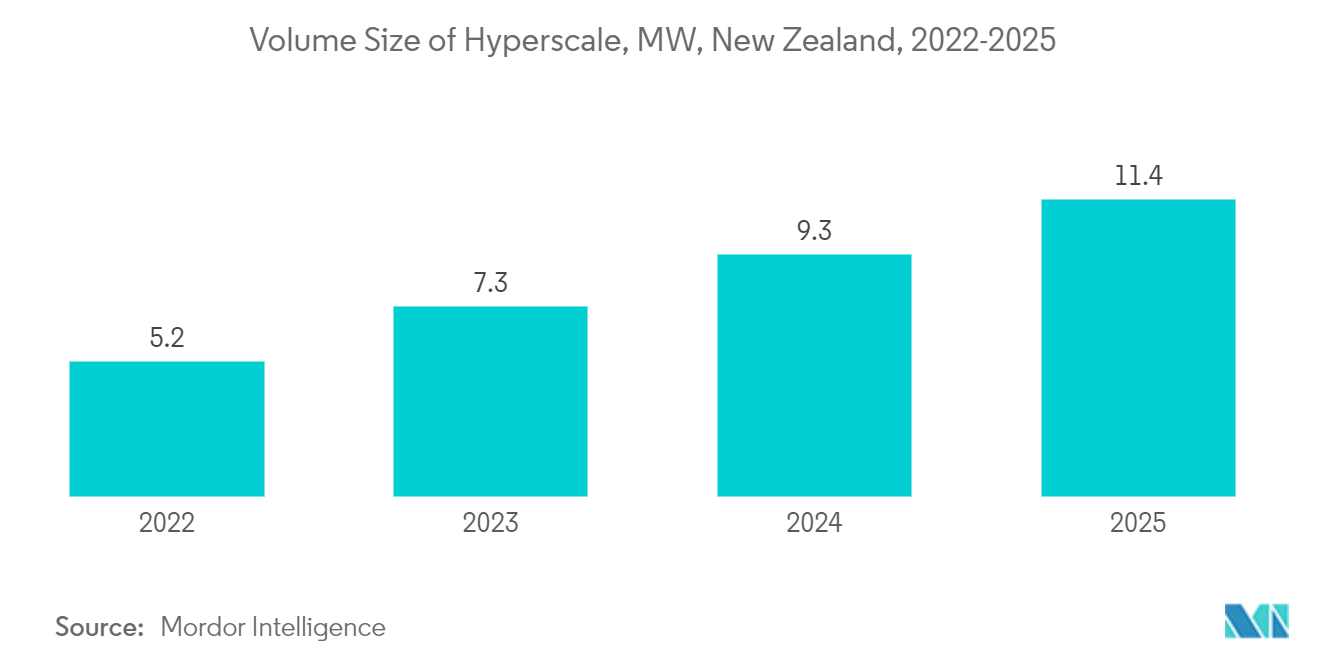
Telecom is Expected to Hold the Highest Market Share
- Introducing the 5G network in New Zealand in March 2021 will likely increase data center investments. Vodafone and Spark have already launched a 5G network. According to Opensignal, Vodafone customers with a 5 G-enabled device and subscription had an active 5G connection of 3.9% of the time compared to Spark, which had an active connection of 2.9% of the time.
- Telecommunications methods have changed over the years, and New Zealanders need reliable telecommunications services for many aspects of their daily lives. The proportion of active internet users has increased overall in line with global trends, supporting the country's ongoing digital transition. The Ultra-Fast Broadband Initiative is a New Zealand government program to build a fiber optic network covering 87% of the population by the end of 2023. It is a public-private partnership between the government and four companies, with a total government investment of NZD 1.7 billion.
- The broadband market is experiencing slow growth, driven primarily by new building construction in greenfield developments or urban renewals. The UFB government project reached over 1.7 million facilities and connected 63%, or 1.1 million. Fixed broadband subscribers are expected to increase due to an increase in households and a decrease in the number of underserved facilities that were previously unconnected.
- Moreover, NZD 15 million (USD 9 million) in funding is earmarked for the launch of the Distant Users Scheme. This initiative aims to provide broadband services to the nation's most remote regions, many of which currently lack any coverage or have limited services limited to voice and text. Additionally, the grant allocates an extra NZD 2 million (USD 1 million) to potentially extend the Marae Digital Connectivity program by up to two years. The scheme's final details are currently being fine-tuned ahead of its launch. This drives the adoption of data centers in the telecom industry in the country.
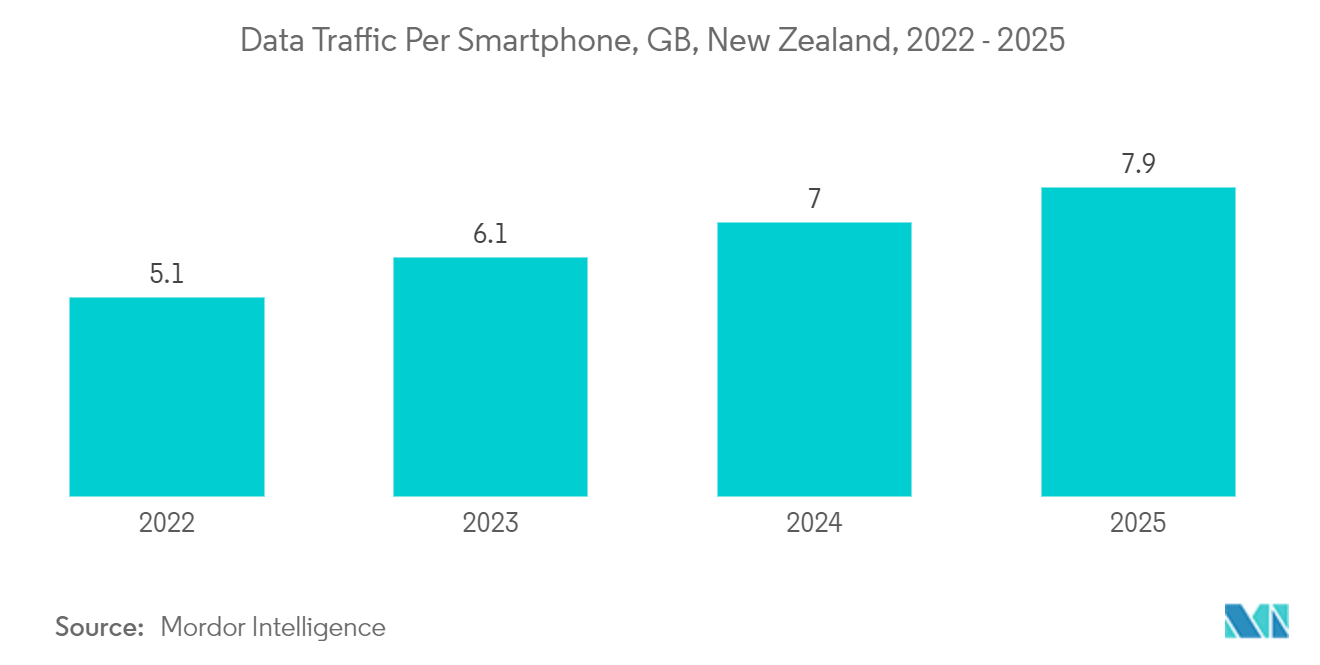
New Zealand Data Center Construction Industry Overview
New Zealand data center construction market is fairly consolidated, with the major companies occupying the majority of the market share. Some of the major companies are AECOM, Arup Group Limited, Aurecon Group Pty Ltd., Turner & Townsend, and Rider Levett Bucknall.
In April 2023, DCI Data Center (DCI Group) announced the completion of its cloud data center in Auckland, New Zealand. The data center is powered by 100% renewable energy to manage the multi-national cloud, classified government, and defense workloads. In addition, the company has plans to combine its Albany facility to offer 50 MW of capacity. This initiative by the company is expected to provide opportunities for new vendors in the market.
In March 2022, T4 Group announced the construction of a tier 4 data center in New Zealand's south island. The project is expected to be built at a cost of USD 34.6 million and would have an IT load capacity of over 11 MW. The construction is expected to be completed by 2024.
New Zealand Data Center Construction Market Leaders
-
AECOM
-
Aurecon Group Pty Ltd.
-
Turner & Townsend
-
Rider Levett Bucknall
-
Arup Group Limited
*Disclaimer: Major Players sorted in no particular order
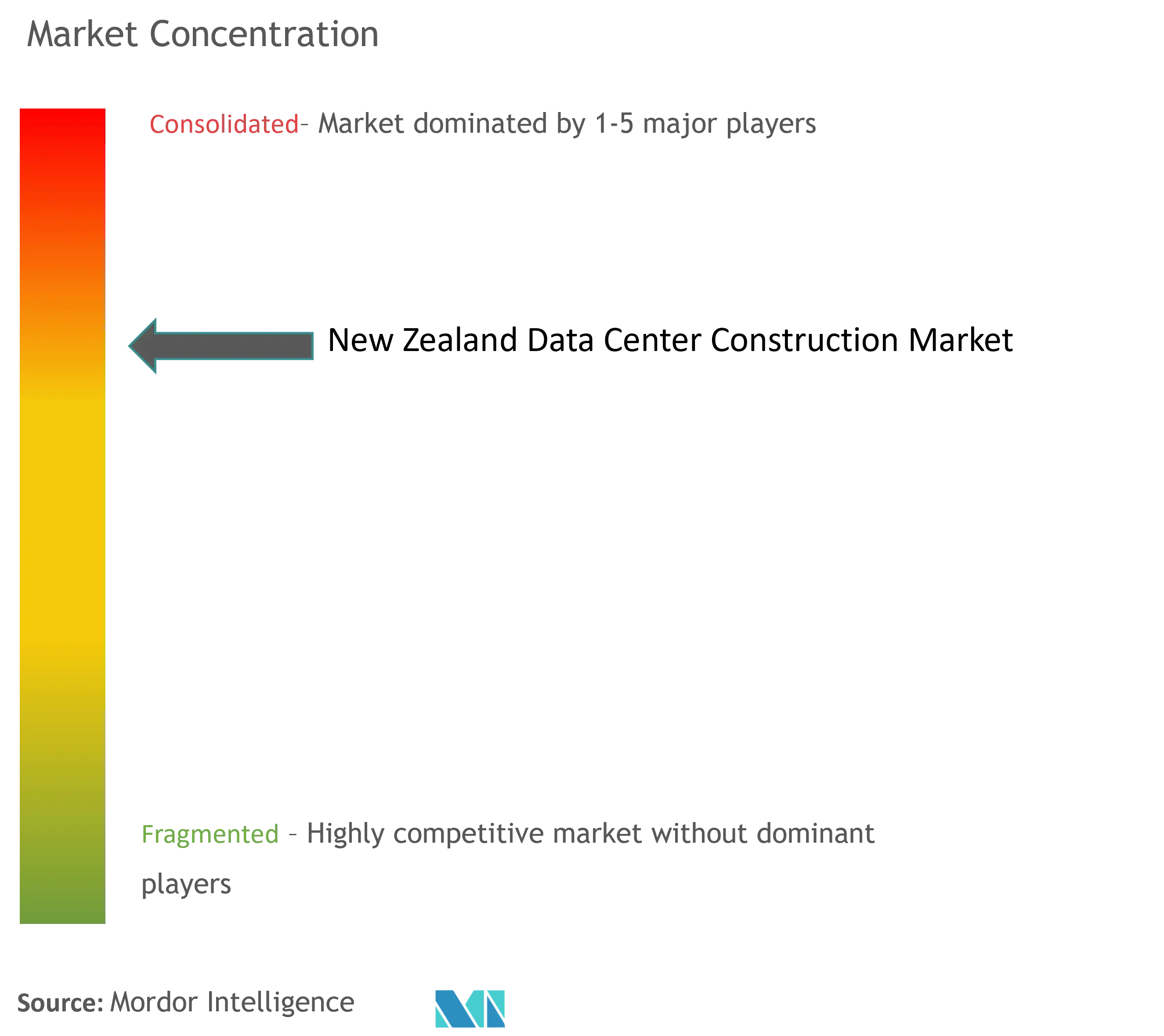
New Zealand Data Center Construction Market News
- February 2024: Spark New Zealand, a telecommunications firm, is set to construct a data center in North Shore, Auckland. This initiative is part of a broader expansion strategy, where the company is not only building three 'large-scale' data center campuses in Auckland but also establishing a network of regional data centers nationwide. The total investment for this expansion is estimated to range between NZD 156-189 million (USD 95-115m).
- April 2023: The government of New Zealand announced the building of a data center worth USD 188 million in its Auckland air force base and is expecting to complete construction by 2025. Such initiatives are expected to provide more opportunities for the vendors studied in the market.
New Zealand Data Center Construction Market Report - Table of Contents
1. INTRODUCTION
1.1 Study Assumptions And Market Definition
1.2 Scope of the Study
2. RESEARCH METHODOLOGY
2.1 Research Framework
2.2 Secondary Research
2.3 Primary Research
2.4 Data Triangulation and Insight Generation
3. EXECUTIVE SUMMARY
4. MARKET INSIGHT
4.1 Market Overview
4.2 Market Dynamics
4.2.1 Market Drivers
4.2.1.1 Rising Generative AI applications and Big Data to boost data center construction
4.2.1.2 Rising Adoption of Green Energy Projects
4.2.2 Market Restraints
4.2.2.1 Increase In Power and Real Estate Costs
4.3 Industry Attractiveness - Porter's Five Forces Analysis
4.3.1 Bargaining Power of Suppliers
4.3.2 Bargaining Power of Consumers
4.3.3 Threat of New Entrants
4.3.4 Threat of Substitutes
4.3.5 Intensity of Competitive Rivalry
4.4 Key New Zealand Data Center Construction Statistics
4.4.1 Number of Data Centers In the New Zealand, 2022 And 2023
4.4.2 Data Center Under Construction in the New Zealand, In Mw, 2024 - 2029
4.4.3 Average Capex and Opex For the New Zealand Data Center Construction
4.4.4 Data Center Power Capacity Absorption In MW, Cities, New Zealand, 2022 and 2023
4.4.5 The top CAPEX spenders on Data center infrastructure in the New Zealand.
5. MARKET SEGMENTATION
5.1 Market Segmentation - By Infrastructure
5.1.1 Market Segmentation - By Electrical Infrastructure
5.1.1.1 Power Distribution Solution
5.1.1.1.1 PDU - Basic & Smart - Metered & Switched solutions
5.1.1.1.2 Transfer Switches
5.1.1.1.2.1 Static
5.1.1.1.2.2 Automatic (ATS)
5.1.1.1.3 Switchgear
5.1.1.1.3.1 Low-Voltage
5.1.1.1.3.2 Medium-Voltage
5.1.1.1.4 Power Panels and Components
5.1.1.1.5 Others
5.1.1.2 Power Back up Solutions
5.1.1.2.1 UPS
5.1.1.2.2 Generators
5.1.1.3 Service - Design & Consulting, Integration, Support & Maintenance
5.1.2 Market Segmentation - By Mechanical Infrastructure
5.1.2.1 Cooling Systems
5.1.2.1.1 Immersion Cooling
5.1.2.1.2 Direct-To-Chip Cooling
5.1.2.1.3 Rear Door Heat Exchanger
5.1.2.1.4 In-Row and In-Rack Cooling
5.1.2.2 Racks
5.1.2.3 Other Mechanical Infrastructure
5.1.3 General Construction
5.2 Market Segmentation - By Tier Type
5.2.1 Tier-I and II
5.2.2 Tier-III
5.2.3 Tier-IV
5.3 Market Segmentation - By End User
5.3.1 Banking, Financial Services, and Insurance
5.3.2 IT and Telecommunications
5.3.3 Government and Defense
5.3.4 Healthcare
5.3.5 Other End Users
6. COMPETITIVE LANDSCAPE
6.1 Company Profiles
6.1.1 AECOM
6.1.2 Arup Group Limited
6.1.3 Aurecon Group Pty Ltd.
6.1.4 Turner & Townsend
6.1.5 Jacobs Solutions Inc.
6.1.6 Rider Levett Bucknall
6.1.7 NZ Strong Group Ltd
6.1.8 Goodman Group
6.1.9 Icon Co.
- *List Not Exhaustive
7. INVESTMENTS ANALYSIS
8. MARKET OPPORTUNITIES AND FUTURE TRENDS
9. ABOUT US
New Zealand Data Center Construction Industry Segmentation
A data center is a physical room, building, or facility that holds IT infrastructure used to construct, run, and provide applications and services and store and manage the data connected with those applications and services. Under data center construction, we are tracking the capital expenditure that was incurred while building the existing data center facilities and also estimating the future capex based on upcoming data center facilities.
The New Zealand Data Center Construction Market is segmented (by Infrastructure (Electrical Infrastructure (Power Distribution Solution(PDU, Transfer Switches, Switchgear, Power Panels and Components, others)), Power Back-up Solution (UPS, Generators), Service – Design & Consulting, Integration, Support & Maintenance)), (Mechanical Infrastructure (Cooling Systems (Immersion Cooling, Direct-to-Chip Cooling, Rear Door Heat Exchanger, In-Row and In-Rack Cooling)), Racks, Other Mechanical Infrastructure)), General Construction)), by Tier Type (Tier 1 and 2, Tier 3, and Tier 4), by End User (Banking, Financial Services and Insurance, IT and Telecommunications, Government and Defense, Healthcare, and Other End User). The market sizes and forecasts are provided in values of USD for all the above segments.
| Market Segmentation - By Infrastructure | ||||||||||||||||||||
| ||||||||||||||||||||
| ||||||||||||||||||||
| General Construction |
| Market Segmentation - By Tier Type | |
| Tier-I and II | |
| Tier-III | |
| Tier-IV |
| Market Segmentation - By End User | |
| Banking, Financial Services, and Insurance | |
| IT and Telecommunications | |
| Government and Defense | |
| Healthcare | |
| Other End Users |
New Zealand Data Center Construction Market Research Faqs
How big is the New Zealand Data Center Construction Market?
The New Zealand Data Center Construction Market size is expected to reach USD 0.67 billion in 2024 and grow at a CAGR of 17.21% to reach USD 1.75 billion by 2030.
What is the current New Zealand Data Center Construction Market size?
In 2024, the New Zealand Data Center Construction Market size is expected to reach USD 0.67 billion.
Who are the key players in New Zealand Data Center Construction Market?
AECOM, Aurecon Group Pty Ltd., Turner & Townsend, Rider Levett Bucknall and Arup Group Limited are the major companies operating in the New Zealand Data Center Construction Market.
What years does this New Zealand Data Center Construction Market cover, and what was the market size in 2023?
In 2023, the New Zealand Data Center Construction Market size was estimated at USD 0.55 billion. The report covers the New Zealand Data Center Construction Market historical market size for years: 2019, 2020, 2021, 2022 and 2023. The report also forecasts the New Zealand Data Center Construction Market size for years: 2024, 2025, 2026, 2027, 2028 and 2029.
New Zealand Data Center Construction Industry Report
Statistics for the 2024 New Zealand Data Center Construction market share, size and revenue growth rate, created by Mordor Intelligence™ Industry Reports. New Zealand Data Center Construction analysis includes a market forecast outlook to for 2024 to 2030 and historical overview. Get a sample of this industry analysis as a free report PDF download.



